Optimization of Structural Steel Used in Concrete-Encased Steel Composite Columns via Topology Optimization
Abstract
:1. Introduction
2. Materials and Methods
2.1. Optimum Design of the Steel Profile via Topology Optimization
Topology Optimization of the Steel Profile Used in the Composite Column
2.2. Nonlinear Modeling of Concrete-Encased Steel Composite Columns
2.2.1. Verification of Nonlinear Modeling
2.2.2. Element Types Used in Composite Column Modeling
2.2.3. Material Properties
2.2.4. Loading and Boundary Condition
2.2.5. Section Properties
3. Results and Discussions
4. Conclusions
- To determine the optimal opening shape within the steel profile body, topology optimization was conducted, resulting in shapes resembling sinusoidal curves. The resulting shape was then adapted for production.
- SOLID65 elements for modeling concrete, SOLID185 for steel profile, and LINK180 for reinforcement were employed in modeling the experiment. The behavior of confined concrete was considered using the Mander model. Additionally, the William Warnke crack model was utilized to describe the nonlinear behavior of concrete, with coefficients of 0.15 for open crack shear load transmission and 0.90 for closed crack shear force transmission. The numerical analyses were validated with experimental results, demonstrating a very close match between the two. As a result, these design parameters can be confidently used for modeling concrete-encased steel composite columns.
- As a result of the nonlinear analysis, it was observed that using the optimally designed steel profile in the composite column, instead of the standard steel profile, increased the load-carrying capacity of the composite column by approximately 19%.
- It was observed that using the optimally designed steel profile in the composite column, instead of the standard steel profile, increased the ductility of the composite column and improved its energy absorption capacity by approximately 24%. Energy absorption capacity was obtained considering the area under load–displacement curves.
- The failure of both composite columns was attributed to the rupture of longitudinal reinforcement. The standard steel profile reached a stress of 272 MPa before failure, while the optimally designed steel profile reached 288 MPa before failure. This indicates that the optimally designed steel profile performs more effectively.
Author Contributions
Funding
Institutional Review Board Statement
Informed Consent Statement
Data Availability Statement
Conflicts of Interest
References
- Azad, S.; Mirghaderi, S.R.; Epackachi, S. Numerical investigation of steel and composite beam-to-encased composite column connection via a through-plate. Structures 2021, 31, 14–28. [Google Scholar] [CrossRef]
- Ren, Q.; Li, M.; Zhang, M.; Shen, Y.; Si, W. Prediction of ultimate axial capacity of square concrete-filled steel tubular short columns using a hybrid intelligent algorithm. Appl. Sci. 2019, 9, 2802. [Google Scholar] [CrossRef]
- Thevendran, V.; Shanmugam, N.E.; Chen, S.; Liew, J.R. Experimental study on steel-concrete composite beams curved in plan. Eng. Struct. 2000, 22, 877–889. [Google Scholar] [CrossRef]
- Lacki, P.; Derlatka, A.; Kasza, P. Comparison of steel-concrete composite column and steel column. Compos. Struct. 2018, 202, 82–88. [Google Scholar] [CrossRef]
- Lai, B.; Liew, J.R.; Wang, T. Buckling behaviour of high strength concrete encased steel composite columns. J. Constr. Steel Res. 2019, 154, 27–42. [Google Scholar] [CrossRef]
- Nasery, M.M.; Hüsem, M.; Okur, F.Y.; Altunişik, A.C. Numerical and experimental investigation on dynamic characteristic changes of encased steel profile before and after cyclic loading tests. Int. J. Civil Eng. 2020, 18, 1411–1431. [Google Scholar] [CrossRef]
- Campian, C.; Nagy, Z.; Pop, M. Behavior of fully encased steel-concrete composite columns subjected to monotonic and cyclic loading. Procedia Eng. 2015, 117, 439–451. [Google Scholar] [CrossRef]
- Lee, C.K.; Khan MK, I.; Zhang, Y.X.; Rana, M.M. Engineered cementitious composites (ECC) encased concrete-steel composite stub columns under concentric compression. Structures 2020, 24, 386–399. [Google Scholar] [CrossRef]
- Hoffstaeter, R.A.; Piloto PA, G.; Martins, C.H.; Rigobello, R. Numerical Investigation on the Fire Resistance of Partially Encased Steel Columns. Int. J. Civil Eng. 2023, 21, 1315–1342. [Google Scholar] [CrossRef]
- Erdal, F.; Doğan, E.; Saka, M.P. Optimum design of cellular beams using harmony search and particle swarm optimizers. J. Constr. Steel Res. 2011, 67, 237–247. [Google Scholar] [CrossRef]
- Durif, S.; Bouchair, A. Analytical model to predict the resistance of cellular beams with sinusoidal openings. J. Constr. Steel Res. 2016, 121, 80–96. [Google Scholar] [CrossRef]
- Xue, J.; Zhao, X.; Ke, X.; Zhang, X.; Zhang, F.; Zhang, P. Experimental and numerical investigation of high-strength concrete encased steel columns with rectangular-spiral stirrups. J. Build. Eng. 2020, 32, 101518. [Google Scholar] [CrossRef]
- TSC-2016; Türkiye Steel Code. Ministry of Construction and Settlement: Ankara, Turkey, 2016.
- Kim, C.S.; Park, H.G.; Chung, K.S.; Choi, I.R. Eccentric axial load testing for concrete-encased steel columns using 800 MPa steel and 100 MPa concrete. J. Struct. Eng. 2012, 138, 1019–1031. [Google Scholar] [CrossRef]
- EN 1994-1-1; Eurocode 4: Design of Composite Steel and Concrete Structures—Part 1-1: General Rules and Rules for Buildings. CEN: Brussels, Belgium, 2004.
- Özkal, F.M.; Uysal, H. A new performance index formulation aiming to attain fully stressed designs for topology optimization problems. Sci. Res. Essays 2010, 5, 2027–2036. [Google Scholar]
- Dangal, B.; Jung, S. The Impact of Additive Manufacturing Constraints and Design Objectives on Structural Topology Optimization. Appl. Sci. 2023, 13, 10161. [Google Scholar] [CrossRef]
- Ribeiro, T.P.; Bernardo, L.F.; Andrade, J.M. Topology optimisation in structural steel design for additive manufacturing. Appl. Sci. 2021, 11, 2112. [Google Scholar] [CrossRef]
- Aribert, J.M.; Campian, C.; Pacurar, V. Monotonic and cyclic behaviour of fully encased composite columns and dissipative interpretation for seismic design. In Stessa; Routledge: London, UK, 2018; pp. 115–121. [Google Scholar]
- ANSYS APDL Version 19.0, Finite Element Analysis Software; ANSYS: Canonsburg PA, USA, 2019.
- Mander, J.B.; Priestley, M.J.; Park, R. Theoretical stress-strain model for confined concrete. J. Struct. Eng. 1988, 114, 1804–1826. [Google Scholar] [CrossRef]
- TBEC-2018; Türkiye Building Earthquake Specifications. Disaster and Emergency Management Authority: Ankara, Turkey, 2020.
- Willam, K.J. Constitutive model for the triaxial behavior of concrete. In IABSE Seminar on Concrete Structure subjected Triaxial Stresses; International Association for Bridge and Structural Engineering: Zurich, Switzerland, 1974; pp. 1–30. [Google Scholar]
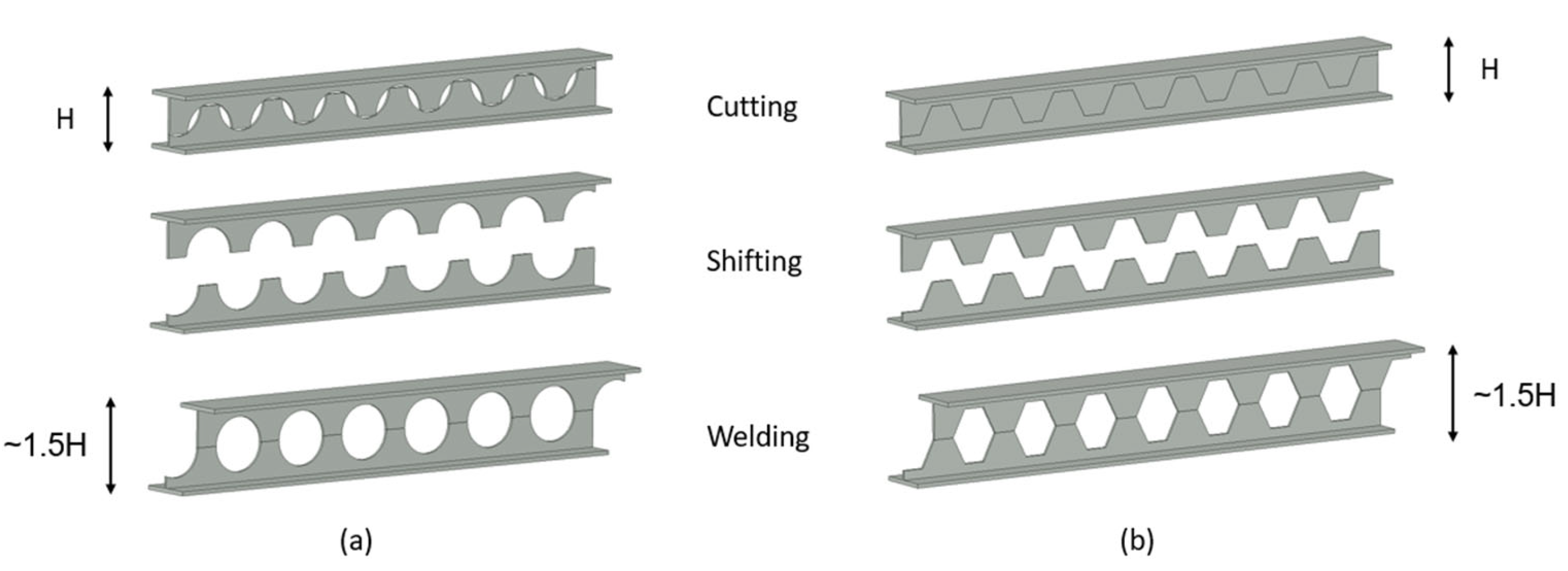
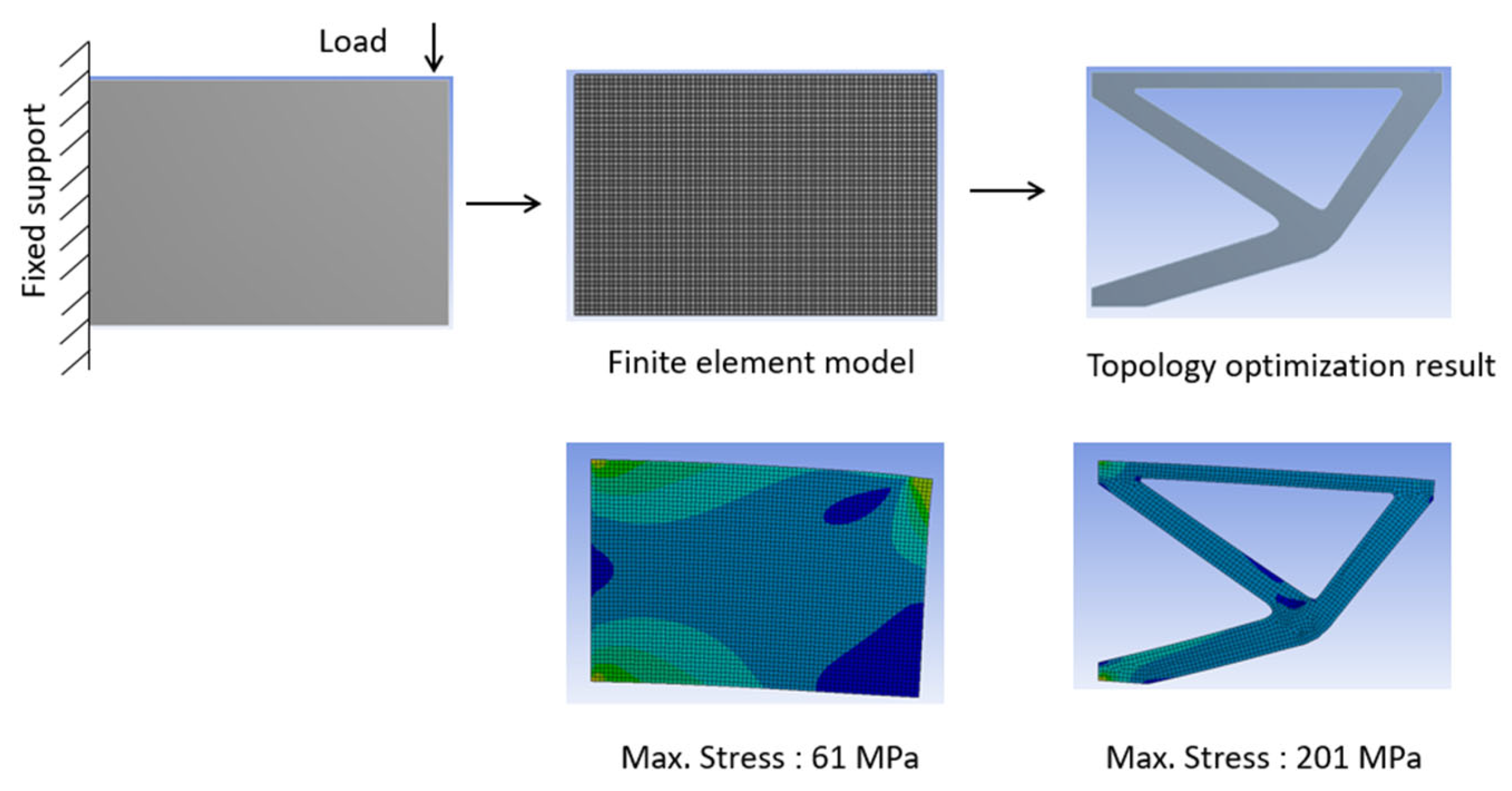

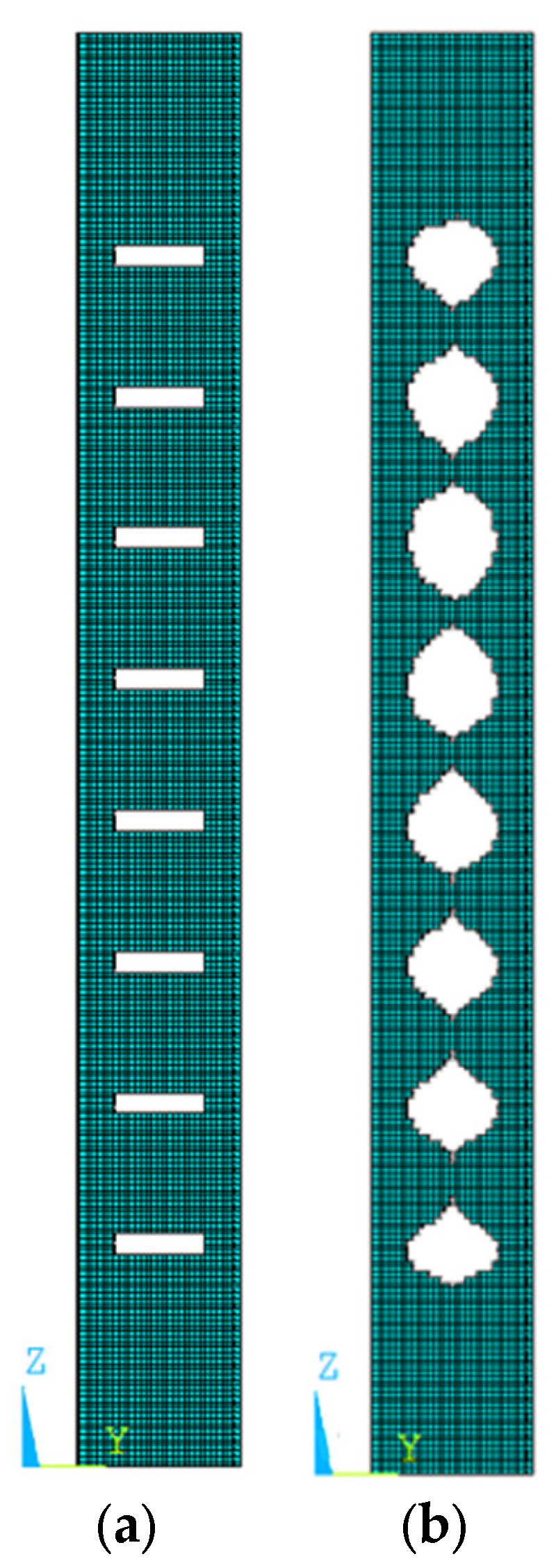



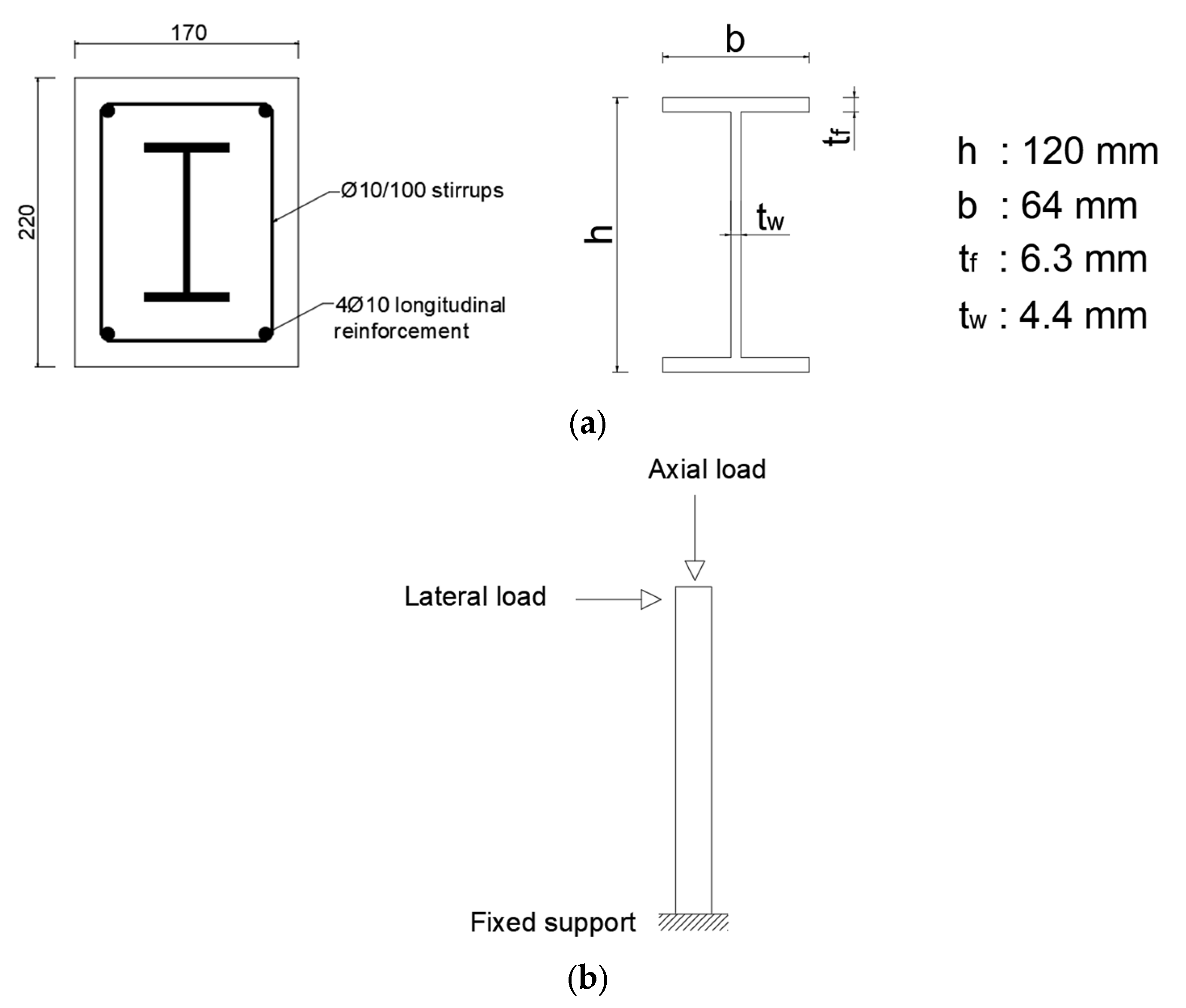

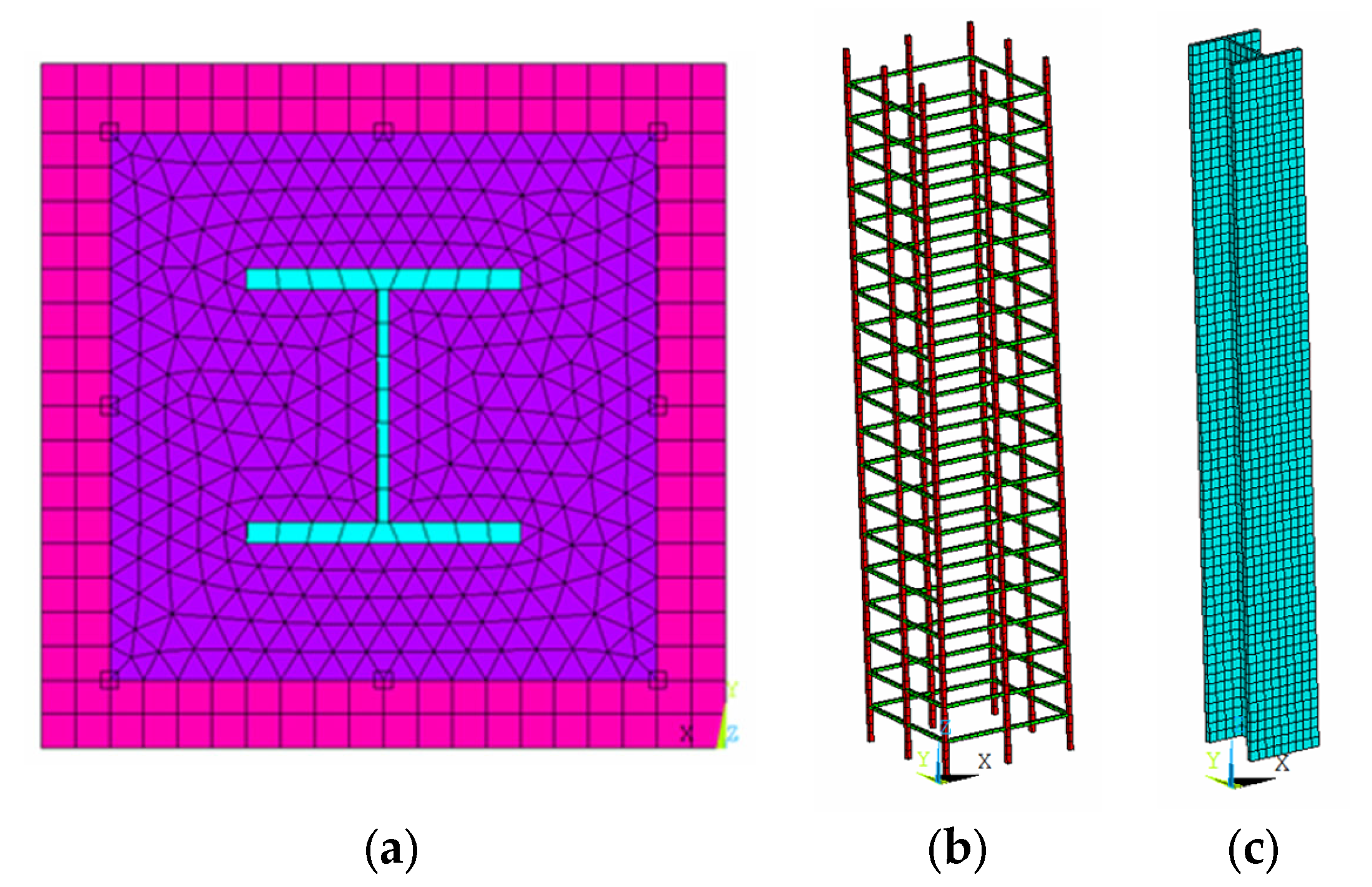
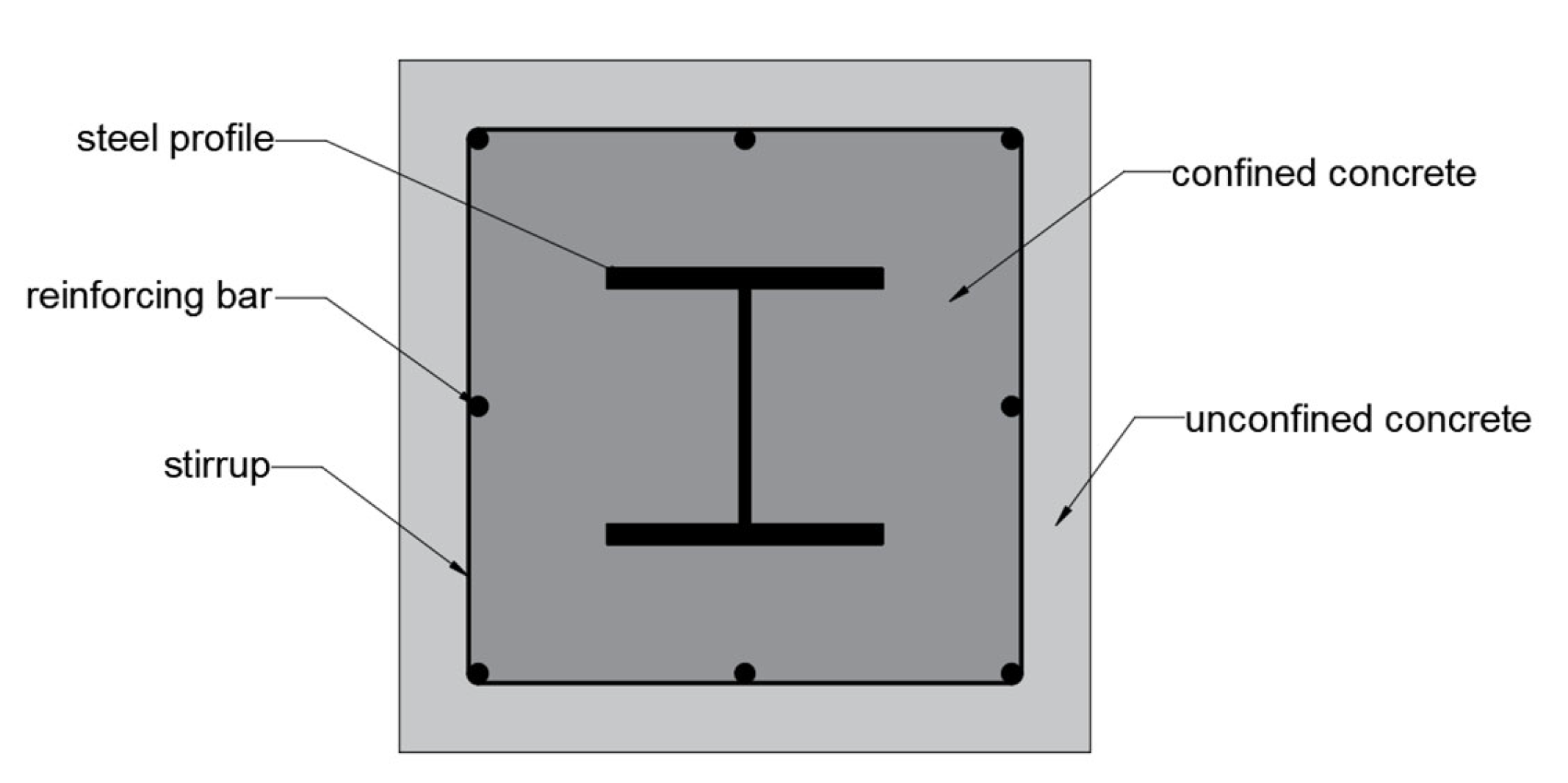
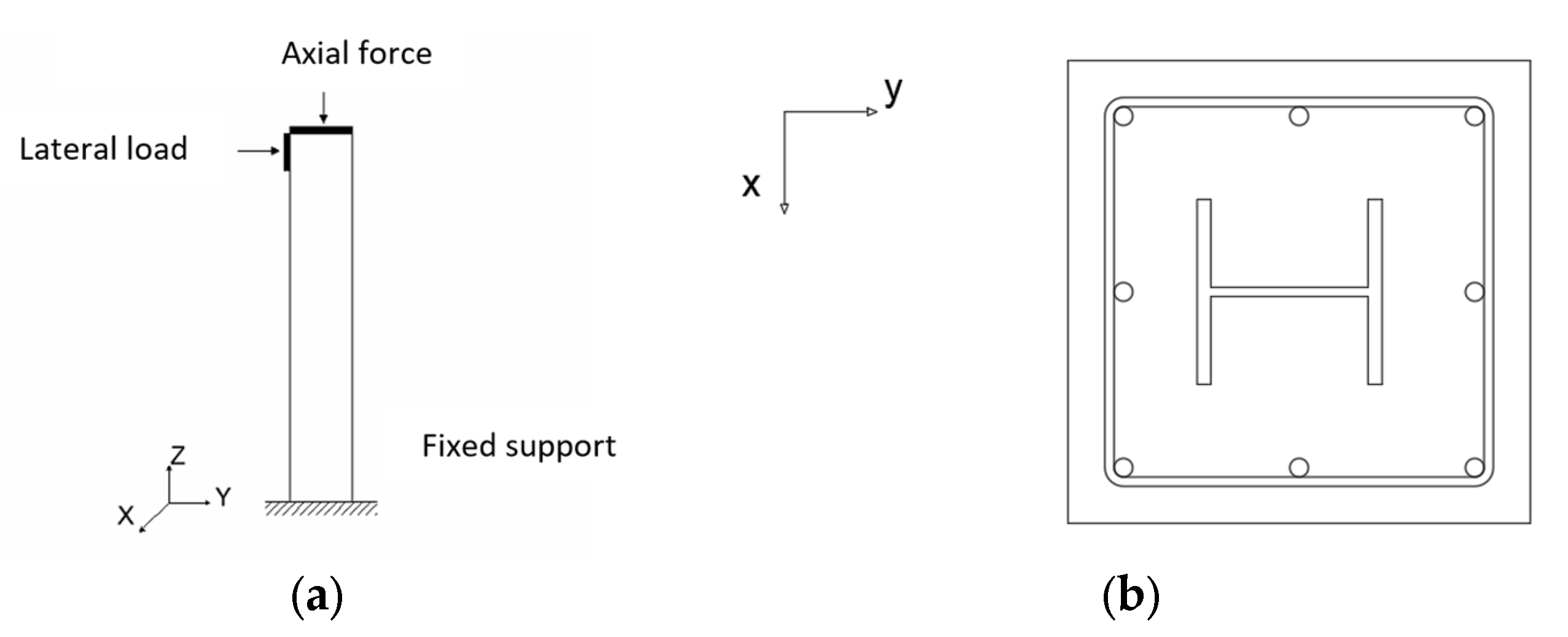
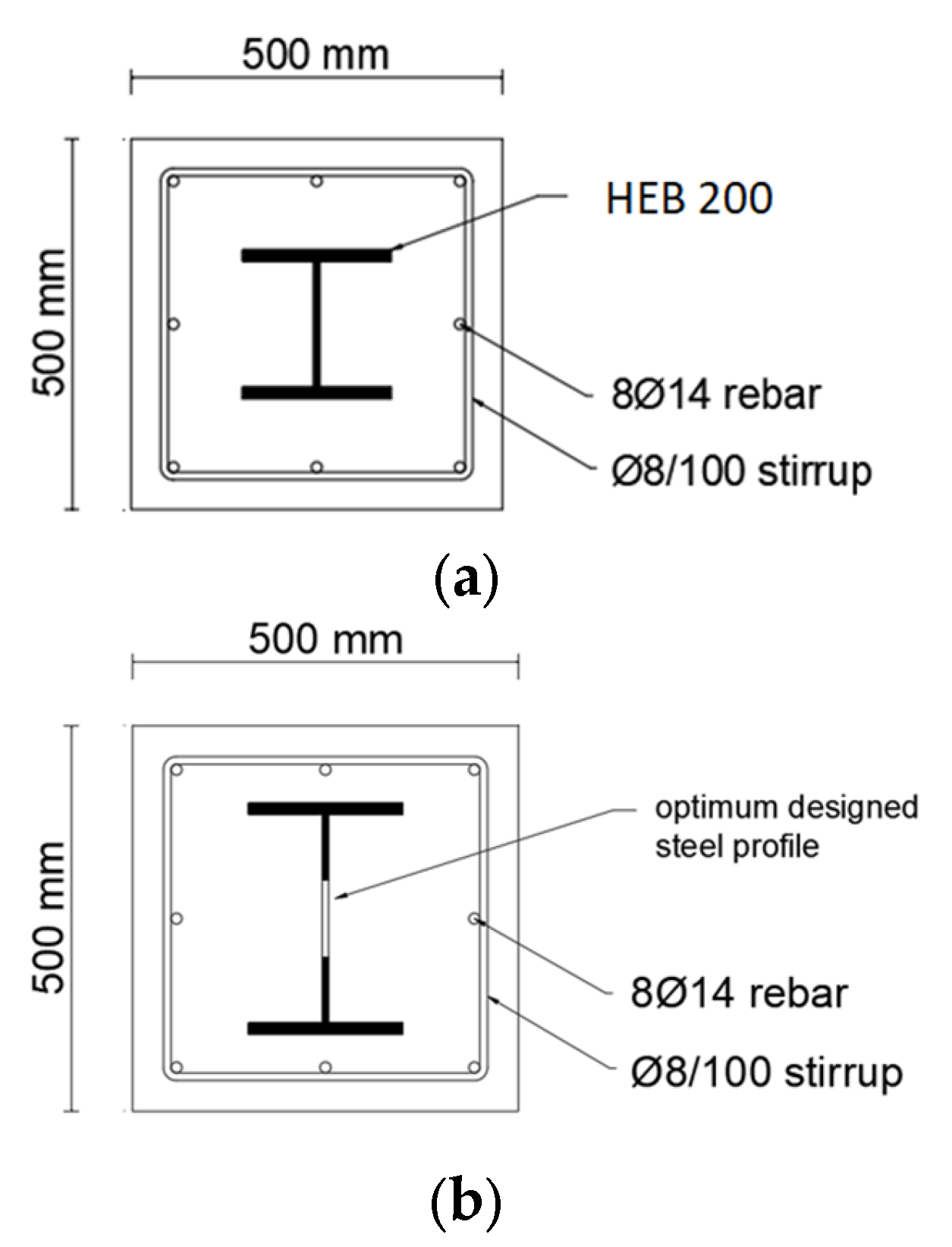
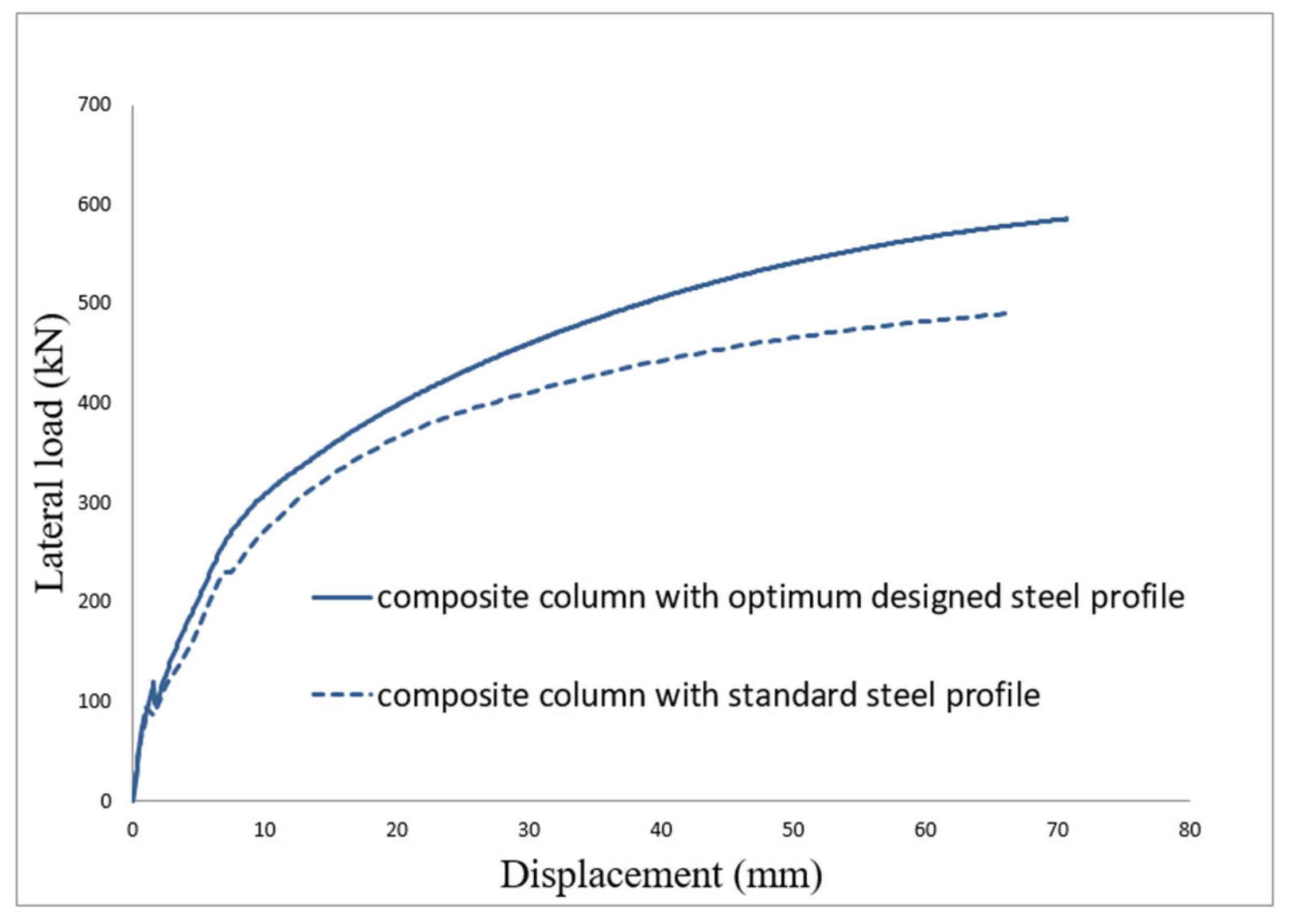
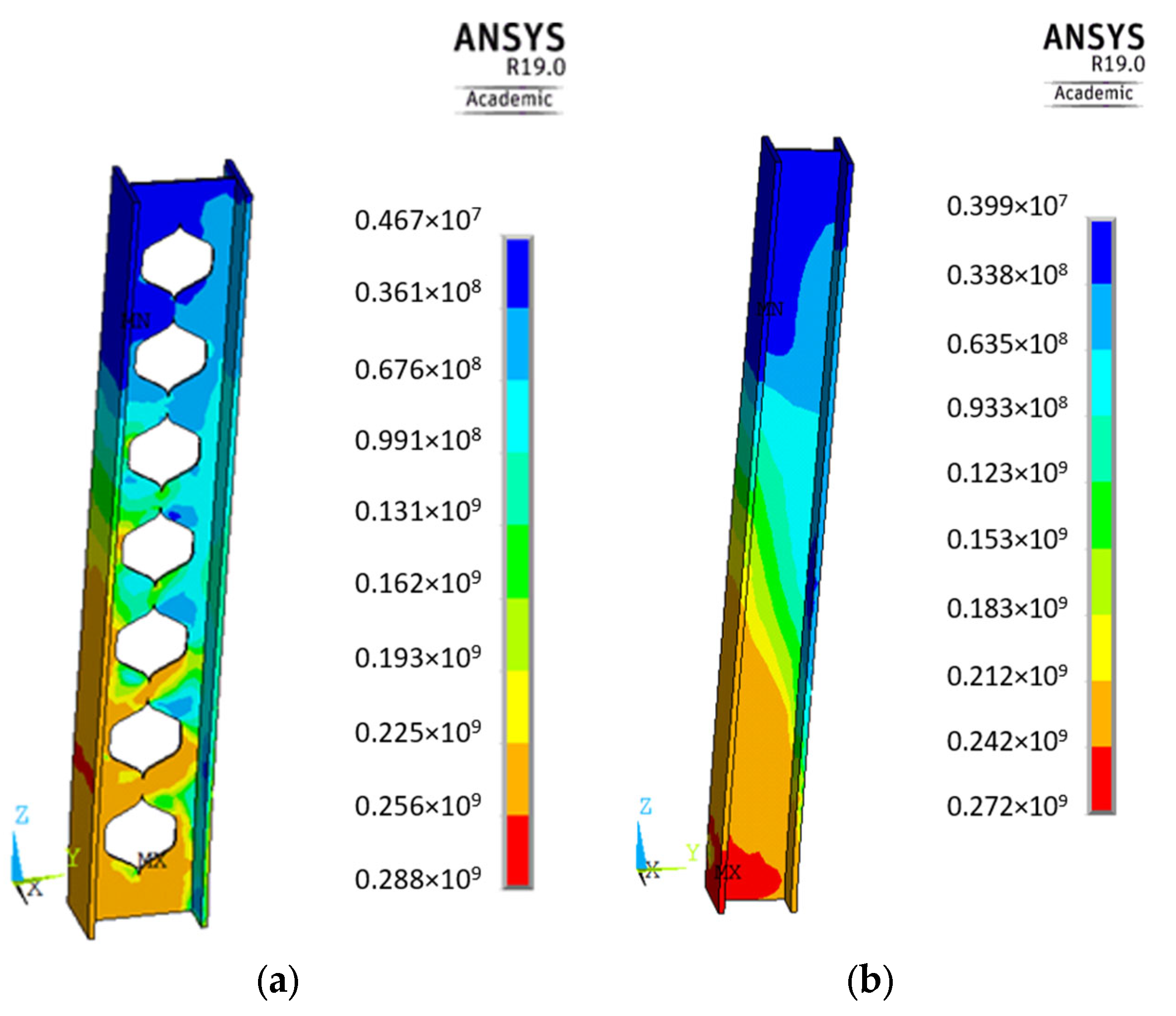
| Composite Column Properties | Experiment Data |
|---|---|
| Column height (m) | 2.0 |
| Concrete compressive strength (MPa) | 25.40 |
| Yield strength of steel profile (MPa) | 302 |
| Yield strength of reinforcement (MPa) | 560 |
| Composite Column with Standard HEB200 | Composite Column with Optimally Designed Steel Profile | Increase Amount (%) | |
|---|---|---|---|
| Lateral load capacity (kN) | 491 | 586 | 19 |
| Maximum lateral displacement (mm) | 67 | 71 | 6 |
| Maximum stress in steel profile (MPa) | 272 | 288 | 6 |
Disclaimer/Publisher’s Note: The statements, opinions and data contained in all publications are solely those of the individual author(s) and contributor(s) and not of MDPI and/or the editor(s). MDPI and/or the editor(s) disclaim responsibility for any injury to people or property resulting from any ideas, methods, instructions or products referred to in the content. |
© 2024 by the authors. Licensee MDPI, Basel, Switzerland. This article is an open access article distributed under the terms and conditions of the Creative Commons Attribution (CC BY) license (https://creativecommons.org/licenses/by/4.0/).
Share and Cite
İnce, E.G.; Özkal, F.M. Optimization of Structural Steel Used in Concrete-Encased Steel Composite Columns via Topology Optimization. Appl. Sci. 2024, 14, 1170. https://doi.org/10.3390/app14031170
İnce EG, Özkal FM. Optimization of Structural Steel Used in Concrete-Encased Steel Composite Columns via Topology Optimization. Applied Sciences. 2024; 14(3):1170. https://doi.org/10.3390/app14031170
Chicago/Turabian Styleİnce, Elif Gökçe, and Fatih Mehmet Özkal. 2024. "Optimization of Structural Steel Used in Concrete-Encased Steel Composite Columns via Topology Optimization" Applied Sciences 14, no. 3: 1170. https://doi.org/10.3390/app14031170





